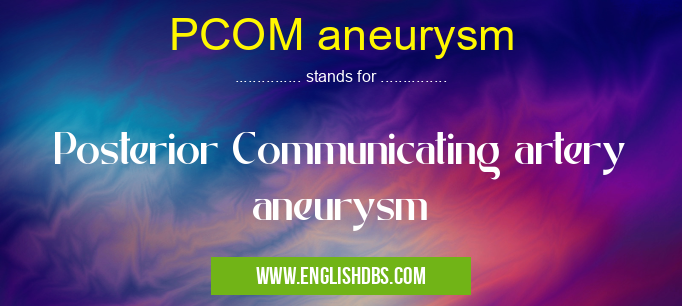What does PCOM ANEURYSM mean in DISEASES
PCOM is a shortform for Posterior Communicating artery aneurysm, which is an abnormal ballooning of the cerebral artery located near the base of the brain. It is a result of weakening in the wall of the artery and can lead to serious health problems or death in severe cases if untreated. The most frequent symptoms associated with PCOM include headaches, visual disturbance, facial pain and nausea.

PCOM aneurysm meaning in Diseases in Medical
PCOM aneurysm mostly used in an acronym Diseases in Category Medical that means Posterior Communicating artery aneurysm
Shorthand: PCOM aneurysm,
Full Form: Posterior Communicating artery aneurysm
For more information of "Posterior Communicating artery aneurysm", see the section below.
Causes
Many factors can contribute to the development or worsening of PCOM, such as high blood pressure, smoking, congenital abnormalities in blood vessels, trauma or tumors that weaken vessel walls. In some cases, it may be related to a genetic disorder such as polycystic kidney disease.
Diagnosis and Treatment
PCOM is often diagnosed through MRI scans or CT scans that detect bulging areas along arteries leading to increased pressure and swelling. Treatment usually involves endovascular techniques where medications or coils are delivered directly into the affected area to reduce pressure and stop further enlargement. Microsurgical clipping may also be used to remove damaged tissue from blocked arteries and prevent further rupture of the aneurysm.
Prevention
Although there is no guaranteed prevention for PCOM aneurysms, controlling factors such as high blood pressure can help decrease risk of its formation and worsening. Maintaining healthy habits including eating nutritional foods, exercising regularly and avoiding drugs can also help reduce risk factors contributing to its development. Avoiding any activities that may cause bumps on the head or putting excessive strain on veins should also be avoided if possible.
Essential Questions and Answers on Posterior Communicating artery aneurysm in "MEDICAL»DISEASES"
What is a PCOM aneurysm?
A Posterior Communicating artery (PCOM) aneurysm is a cerebrovascular condition where the wall of the artery that supplies blood to the brain becomes weakened and causes an out-pouching. This out-pouching, known as an aneurysm, can rupture if not treated in time and cause serious problems.
What are the symptoms of a PCOM aneurysm?
Symptoms of a PCOM aneurysm may include a sudden severe headache, dizziness, nausea, confusion, vision changes or loss of consciousness. These symptoms must be immediately reported to your doctor as they may indicate the onset or progression of an aneurysm.
Who is at risk of developing a PCOM aneurysm?
Risk factors for developing a PCOM aneurysm include high blood pressure, certain medical conditions such as arteriovenous malformation (AVM), genetic predisposition and family history. Other factors such as smoking, heavy alcohol consumption or drug abuse can also increase the risk of developing this condition.
How is a PCOM aneurysm diagnosed?
Your doctor will conduct tests such as CT scans, MRIs and angiograms to diagnose your condition accurately. He may consult with other specialists such as neurologists or neurosurgeons to make sure that none of these tests have missed any underlying issues.
What are the treatments available for a PCOM aneurysm?
Treatment options for PCOM-aneurysms depend on several factors including size and location of the lesion, its shape, how far it has progressed and overall health status of the patient. Generally doctors might recommend surgical procedures like clipping or coiling in order to repair them safely.
Are there any risks associated with treating a PCOM-aneurysm?
As with all medical procedures, there are some risks involved when treating a PCOM-aneurysm such as stroke due to lack of sufficient oxygenation during surgery or temporary paralysis due to nerve damage during treatment procedure itself. However these complications can be minimized if treated under experienced medical staffs.
Can lifestyle changes help in managing my PCOM-aneurysm?
Yes! Adopting healthier habits including quit smoking and avoiding drug use can reduce your risk significantly by maintaining normal blood pressure levels and reducing inflammation in your circulatory system thereby reducing stress on any existing weak spots in the arteries wall.
Is preventive treatment available for people prone to develop PCOM-aneurysms?
To some extent yes! Regular cardiovascular checkup combined with healthy lifestyle choices like exercise and proper diet could help lower down chances for having any kind of brain injury anytime due to weakening on arteries walls.
Final Words:
Posterior Communicating artery aneurysms (PCOM) can potentially lead to serious complications if not treated properly. It's important to understand the causes and seek medical treatment early if symptoms appear. Identifying risk factors associated with PCOM such as family history, high blood pressure levels or lifestyle choices will help prevent further damage from occurring in the future.
PCOM aneurysm also stands for: |
|
| All stands for PCOM aneurysm |
